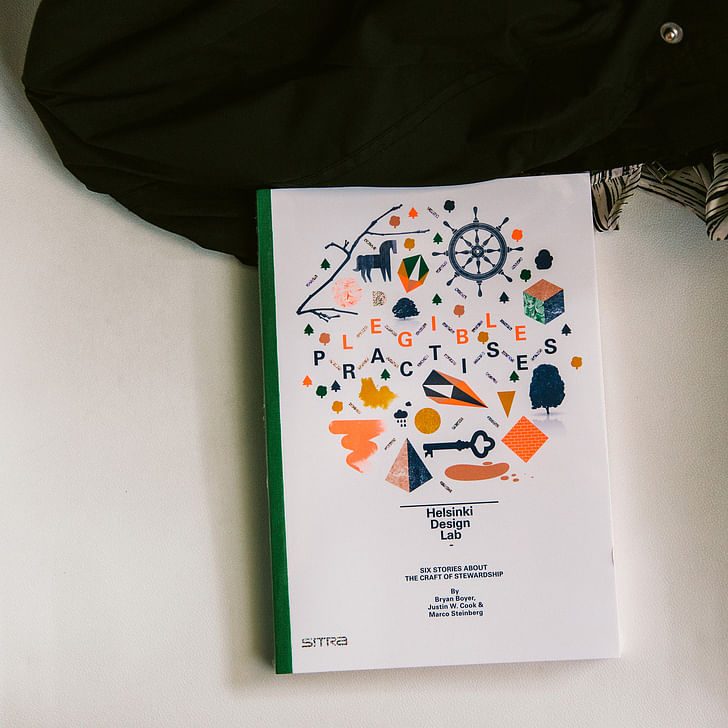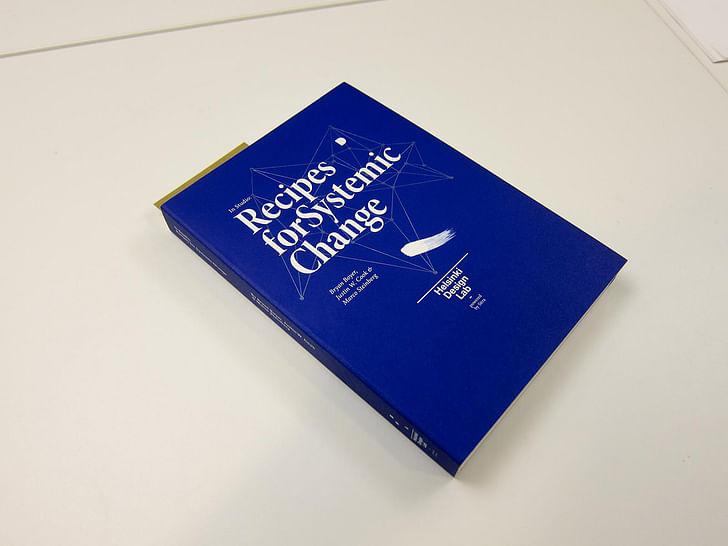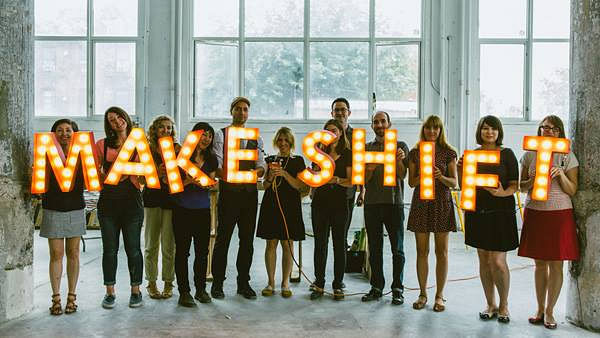

Working out of the Box is a series of features presenting architects who have applied their architecture backgrounds to alternative career paths.
In this installment, we're talking with architect-turned-public-design-instigator Bryan Boyer.
Are you an architect working out of the box? Do you know of someone that has changed careers and has an interesting story to share? If you would like to suggest an (ex-)architect, please send us a message.
Archinect: Where did you study architecture?
Bryan Boyer: I studied interior architecture (renovations and rehabilitation of existing structures) at the Rhode Island School of Design and then did a M.Arch I at Harvard GSD.
At what point in your life did you decide to pursue architecture?
It was a very clear moment. I was twenty one, sitting in the offices of a tech startup that's now long gone, working on a piece of technology that would be considered incredibly mundane today. I had been the seventh employee of that company and enjoyed my experiences there, even up to the moment I left. At that time (2000), the designers you met working on the web were self-taught -- we were all self taught because everything was so new -- and I kept meeting smart people who I admired that had studied architecture and then ended up building the web. When I decided to go back to school to complete my undergrad degree I thought about the thing that I enjoyed most in my work, and it was not so much the pixels and code but the way that those things enabled communities to do new things together. Architecture is an extension of that, manifested through different materials. It seemed natural at the time -- or maybe I was just copying the smart people I admired.
When did you decide to stop pursuing architecture? Why?
After graduating from school, I sat down to make a list of architects I would like to work for and I allowed myself to consider moving anywhere in the world. If the work was good, I'd move. The list I came up with was about five firms long, and none of them were so inspiring to me that I was excited to think about working insanely long hours as a grunt making very little money. This very pragmatic consideration coincided with an intriguing offer from Marco Steinberg, a professor who I had studied under and worked for during school. He had just started a design team at the Finnish Innovation Fund, Sitra, and asked me to be part of the founding team. Sitra is an innovation agency that reports to parliament. We would be the first designers they'd ever hired.



Once again I found that my interest was in the 'architecture' of systems and how they're made, not so much in the specific materials of bricks and mortar.Marco's incredible, so it was enticing to be able to work with him again, and the possibility of utilizing design inside the government, to help make progress on incredibly difficult issues like climate change, welfare services, and education was too good to pass up. Once again I found that my interest was in the 'architecture' of systems and how they're made, not so much in the specific materials of bricks and mortar.
While in school, I had taken a number of odd jobs and projects from doing strategic design research on healthcare and business with Marco, to designing and building the online version of our materials lab, to writing a school blog on Archinect. In retrospect, it's this variety of nontraditional endeavors that prepared me to think more broadly about my skill set after school.


Describe your current profession.
After five years with Sitra establishing Helsinki Design Lab, doing projects like Open Kitchen, Brickstarter, Low2No and writing a couple books, I decided that it was time for me to move back to the states to be closer to family, friends, and fresh avocados. I'm doing a couple things now, but I guess if I had to use one word it's entrepreneur. These days I split my time between some consulting with clients who are interested in integrating design as part of their organization but don't know how to make that happen; I'm part of a small architecture firm called Dash Marshall; and I'm a co-founder of Makeshift Society Brooklyn, which will be a coworking space for creative entrepreneurs.

Makeshift is my primary focus at the moment due to the all-consuming nature of launching a new business. We've just signed a lease for 4000 square feet in Williamsburg and will be opening our doors in early 2014. I'm most excited about this project because I want to search out new models of creative business practice that exist somewhere between being a studio of a few people scraping by and signing up to work at a mega firm. A world where more people can pay their bills by pursuing their passions is the kind of world I want to live in, and we think that Makeshift can play a role in making that an option for more people.
Are you involved in the existing Makeshift SF?
Yes, I've been on the board of directors of Makeshift Society since it started and have been helping Rena, the founder, in small ways since before Makeshift crystallized. What she has been able to accomplish in just a year was impressive enough that I decided to become more involved in the business as we expand to NYC.

Did your experience in Finland, a country known for its relative high degree of "socialism", affect your perspective on communal work environments?
Finland is a Nordic welfare state where the primary thing that's shared is a high level of trust. Every time I would come back to the US on holidays, I would have to remember not to leave me laptop at the table in public, that's how safe things can be in Helsinki. That being said, Helsinki might have shared studios and the like but it does not have much in the way of genuinely open work environments where anyone can apply for a desk. Almost ironically, the strength of personal networks in Finland makes it more difficult for newcomers to find their way into the community. I spent more than a year before really finding a community of designers and other creatives!
At Makeshift we believe that great things come from the unexpected -- and for that to happen you have to leave the door open.When thinking about Makeshift we're very serious about openness: we try our best to make it an organization that has a strong public face. You don't need to know someone to get in, you just say "hi, I'm interested!" This also plays out architecturally: whereas most of the other coworking spaces are on higher floors, somewhere up in the sky, we're committed to having a ground floor facade because we need to be part of the life of the street, where people can poke their head in. At Makeshift we believe that great things come from the unexpected -- and for that to happen you have to leave the door open.
What skills did you gain from architecture school, or working in the architecture industry, that have contributed to your success in your current career?
What I still find useful from architecture school on a daily basis is the notion that you work between abstract intentions and contingent reality. For me the design process is a back and forth between sketching out something perfect and figuring out how to implement something in an imperfect world with as much fidelity as possible. Being able to iterate through this is something that we promoted as a core skill of good designers when explaining design to policy makers. This describes what happens when I sit down to draw a building, a detail, or think about a business plan. To be able to maintain both goals at the same time is an incredibly optimistic thing that's buried in the core of an architectural approach.
The architectural understanding of scale is also hugely important. The exercise of identifying the critical scales at which you examine and represent ideas without getting bogged down with the requirement to make decisions about -- and draw -- every single thing is important. So much of what I do is collaborative that learning to know when it's OK to let go and when you have to hold tight is essential, and I liken that to the moment in the design process when you begin crystalizing your thoughts into representations.
I regret not learning more about real estate, finance, economics, and business when I was in school.Architecture education has been a great platform for me, but there are also some glaring gaps. I regret not learning more about real estate, finance, economics, and business when I was in school. These concerns are not external to architecture, they're what shape it. Too bad I learned to appreciate professional practice courses five years after I graduated! The curriculum is so full that there's hardly any room to add new courses, but I strongly encourage anyone in school to carve out some time for these kinds of courses. You can learn Rhino on Youtube but it's not so easy to grok IRR without someone to lead you through it. You don't have to worry about leaving school with a strong understanding of these subjects, but a familiarity with the vocabulary will go a long way.
More mundane things like a fluency with producing a wide variety of media proves to be helpful again and again. Most recently, while making the video for our Makeshift Society Kickstarter campaign, I made great use of Rhino and an Xacto blade. Thank you, "Unfold"!
Do you have an interest in returning to architecture?
It is incredibly satisfying to draw something exquisite from time to time, and the inescapable tangibility of architecture is a true pleasure. For a while I fulfilled this by working on books and posters and other media, and I should add that being the client for design work can be its own very rewarding experience. At Sitra I was lucky to be able to work with great people like TwoPoints, Rumors, KOKO3, Arup, and Sauerbruch Hutton. Clearing the way for them to do their best work felt useful and meaningful.
Still, for me there's nothing quite as nice as standing in a room you helped design. My involvement in Dash Marshall provides just enough of an opportunity to do traditional architecture work. I'm the slowest person in the office when it comes to traditional design tasks, but my partners are very patient. We're starting to do more work helping our clients at a strategic level, and that's a great way for me to link together a couple different threads of my meandering career.
Paul Petrunia is the founder and director of Archinect, a (mostly) online publication/resource founded in 1997 to establish a more connected community of architects, students, designers and fans of the designed environment. Outside of managing his growing team of writers, editors, designers and ...
4 Comments
very good article and very interesting career path. Very inspiring, Bryan.
No matter what somebody does, they should product some tangible result, even if it is three degrees of separation.
Love it!
Very inspiring. It reminds me Frank Gehry who while driving trucks realized that he want to become the architect. We must constantly review our plans, to find the branch in which we work most efficiently.
Block this user
Are you sure you want to block this user and hide all related comments throughout the site?
Archinect
This is your first comment on Archinect. Your comment will be visible once approved.